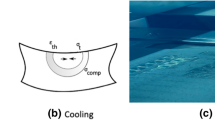Abstract
The effect of the sintering and sinter-hardening temperature on the dimensional and geometrical precision of ring-shaped parts was investigated. The parts were produced with a 3%Cr-0.5%Mo-0.5%C steel, compacted to 6.8 g/cm3 and sinter/sinter-hardened at 1250°C, 1300°C and 1350°C. The increase in the sintering temperature enhances the fraction of load bearing section and leads to an expected significant improvement of mechanical properties. Dimensional shrinkage increases with the sintering temperature, however, the dimensional and geometrical precision obtained in all the cases is very good even at very high sintering temperature. Dimensional variations are anisotropic, and the effect of anisotropy was estimated by evaluating the lack of precision attained when green parts are designed assuming an isotropic behavior.
Similar content being viewed by others
Abbreviations
- A:
-
area of the cross section of the pore [μm2]
- cext :
-
circumference related to the external diameter in the sintered/ sinter-hardened part [mm]
- cext 0 :
-
circumference related to the external diameter in the green part [mm]
- cint :
-
circumference related to the internal diameter in the sintered/ sinter-hardened part [mm]
- cint 0 :
-
circumference related to the internal diameter in the green part [mm]
- De :
-
external diameter of the sintered/sinter-hardened part [mm]
- De0 :
-
external diameter of the green part [mm]
- Deq :
-
equivalent diameter of pore [μm]
- Dext :
-
required value for the external diameter of the final part [mm]
- Di :
-
internal diameter of the sintered/sinter-hardened part [mm]
- Di0 :
-
internal diameter of the green part [mm]
- Dint :
-
required value for the internal diameter of the final part [mm]
- fcircle :
-
shape factor
- h :
-
height of the sintered/sinter-hardened part [mm]
- H:
-
required value for the height of the final part [mm]
- h0 :
-
height of the green part [mm]
- P:
-
perimeter of the cross section of the pore [μm]
- t:
-
wall thickness in the sintered/sinter-hardened part [mm]
- t0 :
-
wall thickness in the green part [mm]
- w:
-
maximum deviation of measured θ from the nominal value in the sintered/sinter-hardened part
- w0 :
-
maximum deviation of measured θ from the nominal value in the green part
- ΔV/V0 :
-
volume change
- Δθ:
-
maximum difference between θ in the sintered/sinter-hardened part and θ in the green part
- Φ:
-
fraction of load bearing section
- ɛ:
-
fractional porosity
- ɛi :
-
isotropic dimensional change
- ɛr :
-
dimensional change in the radial direction
- ɛz :
-
dimensional change in the axial direction
- ɛθ ext :
-
dimensional change in the tangential direction in the external circumference
- ɛθ int :
-
dimensional change in the tangential direction in the internal circumference
- θ:
-
angle formed by the median planes of the grooves in the sintered/ sinter-hardened part [°]
- θ0 :
-
angle formed by the median planes of the grooves in the green part [○]
References
Bocchini, G. F., “Influence of process parameters on precision of PM parts,” Powder Metallurgy, Vol. 28, No. 3, pp. 155–165, 1985.
German, R. M., “Powder Metallurgy of Iron and Steel,” John Wiley & Sons Inc., pp. 205–209, 1998.
Marcu Puscas, T., Signorini, M., Molinari, A., and Straffelini, G., “Image analysis investigation of the effect of the process variables on the porosity of sintered chromium steels,” Materials Characterization, Vol. 50, No. 1, pp. 1–10, 2003.
Molinari, A. and Stoyanova, V., “Vacuum sintering and sinterhardening of Mo and Ni low alloyed steels,” Powder Metallurgy Progress, Vol. 4, No. 2, pp. 79–87, 2004.
Tengzelius, J. and Blände, C. A., “High temperature sintering of PM steels,” in: New Perspectives in Powder Metallurgy: High Temperature Sintering, Sanderow, H. I., (Ed.), Metal Powder Industries Federation, pp. 217–228, 1990.
Pietrowski, A. and Biallas, G., “Influence of Sintering Temperature on Pore Morphology, Microstructure, and Fatigue Behaviour of MoNiCu Alloyed Sintered Steel,” Powder Metallurgy, Vol. 41, No. 2, pp. 109–114, 1998.
Azadbeh, M., Gierl, C., and Danninger, H., “Elastic Properties of Cr-Mo Alloyed Sintered Steels: A Comparison of Dynamic and Static Young’s Moduli,” Powder Metallurgy Progress, Vol. 6, No. 1, pp. 1–10, 2006.
Danninger, H. and Gierl, C., “New Alloying Systems for Ferrous Powder Metallurgy Precision Parts,” Science of Sintering, Vol. 40, pp. 33–46, 2008.
Cristofolini, I., Rao, A., Menapace, C., and Molinari, A., “Influence of sintering temperature on the shrinkage and geometrical characteristics of steel parts produced by Powder Metallurgy,” Journal of Materials Processing Technology, Vol. 210, pp. 1716–1725, 2010.
Cristofolini, I., Pilla, M., Rao, A., Molinari, A., and Libardi, S., “Dimensional and geometrical control of PM parts sintered at low and high temperatures,” Proc. of the International Conference on Powder Metallurgy & Particulate Materials, Vol. 1, pp. 19–26, 2010.
Hatami, S., Malakizadi, A., Nyborg, L., and Wallin, D., “Critical aspects of sinter-hardening of prealloyed Cr-Mo steel,” Journal of Materials Processing Technology, Vol. 210, pp. 1180–1189, 2010.
Molinari, A., Menapace, C., and Girardini, L., “Vacuum sinterhardening and sinteraustempering of low-alloy steels,” Proc. of the International Conference on Powder Metallurgy & Particulate Materials, Vol. 5, pp. 79–86, 2009.
Cristofolini, I., Menapace, C., Rao, A., Cazzolli, M., Pahl W., and Molinari, A., “The effect of anisotropic dimensional change on the precision of steel parts produced by powder metallurgy,” Journal of Materials and Processing Technologies, Vol. 7, No. 212, pp. 1513–1519, 2012.
DEA, “Global — status, image, activ,” 2002.
ISO 10360-2, “Geometrical Product Specifications (GPS) — Acceptance and reverification tests for coordinate measuring machines (CMM) — Part 2: CMMs used for measuring size.,” 2001.
ISO 10360-4, “Geometrical Product Specifications (GPS) — Acceptance and reverification tests for coordinate measuring machines (CMM) — Part 4: CMMs used in scanning measuring mode.,” 2000.
Molinari, A., Menapace, C., Santuliana, E., and Straffelini, G., “A simplified model for the impact resistance of porous sintered steels,” Powder Metallurgy Progress, Vol. 11, No. 1–2, pp. 12–20, 2011.
ISO 286-1, “ISO system of limits and fits — Part 1: Bases of tolerances, deviations and fits,” 1988.
ASME Y14.5-2009 [Revision of ASME Y14.5M-1994 (R2004)]. Dimensioning and Tolerancing — Engineering Drawing and Related Documentation Practices. The American Society of Mechanical Engineers, Three Park Avenue, New York, NY 10016-5990, 2009.
“Guida alla progettazione dei componenti sinterizzati,” Assinter, 1995.
Cristofolini, I., Selber, F., Menapace, C., Pilla, M., Molinari, A., and Libardi, S., “Anisotropy of Dimensional Variation and its Effect on Precision of Sintered Parts,” Proc. of EUROPM Congress & Exhibition, Vol. 1, pp. 519–524, 2012.
Cristofolini, I., Pilla, M., Molinari, A., and Larsson, M., “Study of the effect of powder mixture on the geometrical characteristics of PM copper steel parts by DOE analysis,” Proc. of EUROPM Congress & Exhibition, Vol. 3, pp. 205–410, 2011.
Cristofolini, I., Pilla, M., Rao, A., Pederzini, G., Salemi, A., Crosa, R., and Molinari, A., “Optimization of powder compaction to improve the dimensional characteristics of PM steel parts,” Proc. of PM World Congress, Vol. 1, pp. 441–448, 2010.
Zavaliangos, A. and Bouvard, D., “Numerical Simulation of Anisotropy in Sintering Due to Prior Compaction,” The International Journal of Powder Metallurgy, Vol. 36, No. 7, pp. 59–65, 2000.
Molinari, A., Menapace, C., Torresani, E., Cristofolini, I., and Larsson, M., “Working hypothesis for origin of anisotropic sintering shrinkage caused by prior uniaxial cold compaction,” Powder Metallurgy, Vol. 56, No. 3, pp. 189–195, 2013.
Author information
Authors and Affiliations
Corresponding author
Rights and permissions
About this article
Cite this article
Cristofolini, I., Pilla, M., Rao, A. et al. Dimensional and geometrical precision of powder metallurgy parts sintered and sinterhardened at high temperature. Int. J. Precis. Eng. Manuf. 14, 1735–1742 (2013). https://doi.org/10.1007/s12541-013-0233-5
Received:
Accepted:
Published:
Issue Date:
DOI: https://doi.org/10.1007/s12541-013-0233-5




